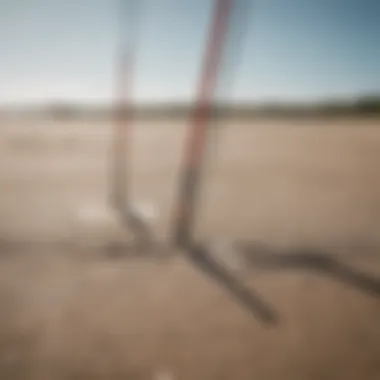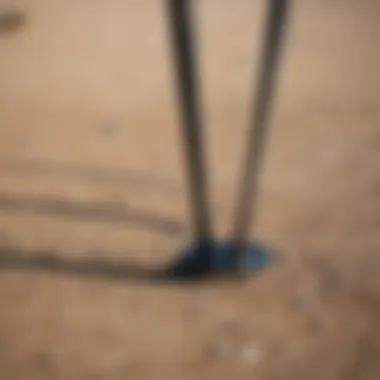Kite Ground Stakes: Key Gear for Kiteboarding


Intro
Kiteboarding, an exhilarating blend of surfing and sailing, has gained immense popularity over the years. Among the critical equipment that often slides under the radar is the kite ground stake. While it may not receive the spotlight that kites themselves do, understanding its design, functionality, and usage can profoundly affect your kiteboarding experience. Think of it like the foundation of a house. Without a sturdy base, the entire structure is compromised.
Ground stakes play a pivotal role in ensuring that your kite remains tethered securely, regardless of wind conditions. Whether you are hitting the waves for the first time or refining your skills as a seasoned kiteboarder, these essential tools have numerous benefits that can enhance both safety and performance.
This article seeks to unravel the complexities of kite ground stakes. From delving into various materials used in their construction to offering maintenance tips, we aim to equip you with the knowledge necessary to select and maintain the right stakes for your adventures. Along the way, we will discuss safety practices and techniques for maximizing your kiteboarding sessions. Let’s embark on this journey to better understand a component that is just as important as the kite itself.
Intro to Kite Ground Stakes
Kiteboarding is an exhilarating sport that relies heavily on various pieces of specialized equipment, and kite ground stakes often go unnoticed in discussions about essential gear. These seemingly simple tools play a vital role in ensuring both the safety and stability of the kite during use. In this segment, we will explore the key elements that define kite ground stakes, how they contribute to your kiteboarding experience, and why they deserve more attention from enthusiasts.
Overview of Kiteboarding Equipment
Kiteboarding combines the thrill of surfing with the power of the wind. The sport requires an array of equipment that includes kites, boards, harnesses, and safety gear. However, each piece serves its purpose in a larger system, and without proper support, even the best kites can falter. Kite ground stakes have a distinct purpose: they secure the kite to the ground, offering resistance against the forces of nature.
When you're out on the water, the wind can change directions quickly, and having a stable setup is crucial. Therefore, understanding the various pieces of your kit, not least the stakes, is indispensable. Their integration allows kiteboarders to enjoy the sport more safely and efficiently.
Importance of Kite Ground Stakes
Diving deeper into kite ground stakes, their importance cannot be overstated. First and foremost, they serve as anchors. When the wind picks up, the stakes ensure that the kite remains grounded, preventing it from blowing away or taking flight unexpectedly. The stakes come in various types and materials, which can vary widely in their effectiveness.
In addition to stability, kite ground stakes also improve safety. A loose kite can lead to accidents—potentially injuring others or damaging equipment. Thus, investing in quality stakes is not merely optional; it's a necessity.
Moreover, a well-secured kite allows the rider to focus on their performance rather than worrying about equipment mishaps. When the kite is stable, riders can better harness their skills, resulting in a stronger and more enjoyable performance.
"Kite ground stakes may be small, but their impact on kiteboarding is anything but minor. Stability enhances performance, safety, and overall enjoyment."
Types of Kite Ground Stakes
Kite ground stakes, while often not at the forefront of kiteboarding discussions, play a pivotal role in ensuring a successful and safe experience on the water. Each type of stake—metal, plastic, and composite—offers unique characteristics that cater to different conditions and preferences. Understanding these types allows kiteboarders to make informed decisions, aiding in better stability and control during their sessions. In kiteboarding, the winds can be unpredictable, and the right stake can spell the difference between a smooth time and one fraught with issues.
Metal Stakes
Metal stakes are typically known for their unparalleled strength and durability. When you have a high wind day or rough weather conditions, these stakes can hold down a kite with the kind of grip that plastic just can't match. Made from materials like stainless steel or galvanized iron, metal stakes resist bending or breaking even under substantial force.
Their design often includes a pointed end that can penetrate more challenging terrains, like rocky surfaces or hard-packed sand. This can provide kiteboarders with a sense of security, knowing that their setup is anchored firmly. An important consideration to keep in mind, however, is the weight; metal stakes can be quite heavy and may not be the most convenient for those carrying a lot of gear or traveling long distances.
Plastic Stakes
Plastic stakes have gained popularity due to their lightweight nature, making them an attractive choice for many kiteboarders. Usually crafted from high-density polyethylene, these stakes are less cumbersome to transport, allowing for easy packing in bags and quick setup at the beach.
One of the main advantages is their resistance to rust and corrosion, especially important for those who frequent saltwater environments. However, it's essential to consider the wind conditions. Generally, plastic can struggle to hold down a kite in high winds compared to metal or composite options. That said, larger plastic stakes with wider bases can counteract this shortcoming, providing decent anchoring capabilities.
"Choosing the right stake can significantly elevate your kiteboarding experience, allowing for better stability and control on the water."
Composite Stakes
Composite stakes represent a blend of the best features of both metal and plastic. Typically made from a combination of materials such as fiberglass or carbon fiber, they offer some unique benefits. Composite stakes generally have a lightweight framework while also possessing enough strength to endure severe conditions.
Their resilience makes them ideal for kiteboarders who demand versatility. They can be designed with a sharp tip allowing for easy penetration of various terrains, paired with a broader base to enhance stability and prevent tipping over. However, these stakes can sometimes be more expensive, which is a consideration for budget-conscious riders.
In summary, each type of kite ground stake has its own strengths and weaknesses. From the heavy-duty, ultra-reliable metal stakes to the lightweight and corrosion-resistant plastic options, and finally to the hybrid nature of composite stakes, the choice should align with the rider's specific needs, conditions, and expectations.
Understanding these differences is vital in making the right decision to ensure optimum performance and safety in kiteboarding.
Design Features of Kite Ground Stakes


In the world of kiteboarding, the design of kite ground stakes plays a pivotal role in ensuring a successful outing. These unassuming pieces of equipment can greatly influence stability and control during kiting. Understanding the elements that define the shape, size, and overall design not only enriches your knowledge but also enhances your kiteboarding experience.
Shape and Size Considerations
When it comes to kite ground stakes, not all are created equal. The shape and size of a stake can make a world of difference in how well it performs in various environments. For instance, longer stakes may provide better hold in softer sand, while shorter ones are easier to drive into harder surfaces.
- Tapered vs. Flat: Tapered stakes can pierce through tough soil with ease, while flat stakes often provide a broader surface area, preventing them from sinking too deep and losing grip.
- Length Matters: A stake that is too short might not hold adequately in windy conditions. On the contrary, an excessively long stake can be cumbersome to carry and requires more effort during installation.
Choosing the right shape and size can greatly affect your overall kite stability and ease of use. A little thought into these design aspects can save a lot of hassle on the beach when the wind picks up.
Anchor Points and Stability
The anchor point is the unsung hero of kite ground stakes. Properly designed anchor points are crucial for maintaining stability while kiting. They secure the kite in place under varying wind conditions, allowing for a smooth ride.
The strategic placement of anchor points plays a vital role:
- Orientation Matters: Ensure the stake is oriented towards the wind to maximize its holding capability. If the stake is misaligned, it could lead to a loss of traction.
- Number of Points: Some stakes have multiple anchor points which allow for various configurations. For example, you can stake down the lines at various angles for added security against sudden gusts.
"A well-anchored kite can mean the difference between soaring high and crashing down low.”
Inadequate anchoring can lead to mishaps, such as the kite rolling in strong gusts or even getting caught in a tree. Therefore, understanding the functionality of anchor points is imperative. With the right design features and anchor points in consideration, kite ground stakes contribute significantly to the overall safety and control in kiteboarding.
How to Properly Use Kite Ground Stakes
Knowing how to properly use kite ground stakes is vital for all kiteboarders, regardless of their experience level. A good understanding of installation and management can spell the difference between a smooth ride and a potential mishap. Using the right techniques not only enhances your kite’s stability but also your overall kiteboarding experience, making it all more enjoyable and exhilarating.
Choosing the Right Location
Think of the location as the foundation of your kiteboarding adventure. The right site for your stakes can significantly influence your kite's performance. Start by scouting an area that’s free of obstacles, like rocks, trees, and power lines. Look for a spot where there’s ample space to allow your kite to fly high and with minimum interference.
- Flat Terrain: A flat area is ideal as it minimizes the risk of letting winds catch your kite off guard.
- Wind Direction: Always determine the wind direction before you stake your kite. Setting up against the wind ensures an easier launch.
- Tidal Changes: If you're near water, be mindful of tidal changes. Setting up on higher ground helps avoid sudden shifts in elevation that can occur with rising tides.
In addition, always consider who else might be in the vicinity. Staying clear of crowded areas means you’re not only keeping yourself and your kite secure, but also showing courtesy to fellow kiteboarders.
Installation Techniques
Installing kite ground stakes isn’t just a mechanical task; it’s a strategy. Proper installation involves careful attention to detail, ensuring that your stakes are firmly anchored.
- Drive Deep: When you plant the stakes, ensure they're driven deep into the ground. A rule of thumb might be to bury two-thirds of the stake's length for maximum security.
- Angle the Stakes: Positioning the stakes at a slight angle toward your kite will greatly enhance stability. This way, they can better withstand the forces acting on your kite during wind changes or sudden gusts.
- Use Multiple Stakes: For larger kites or heavy winds, consider using multiple stakes connected to your kite. This distributes the load and minimizes the risk of one stake failing.
Be methodical in your setup. Test the anchored stakes by pulling gently on the lines to ensure nothing is loose. If it wiggles like a fish out of water, it’s time to re-evaluate its placement.
Adjusting for Weather Conditions
A kiteboarder's nemesis is changing weather, and adapting your stakes accordingly is essential. Pay attention to the forecasts and be prepared for sudden changes. Here’s what to remember:
- Wind Shifts: If winds start to pick up, ensure that your stakes are tight and secure. You might need to reposition them based on how the wind patterns are behaving.
- Watery Environments: When kiteboarding by the water, be particularly cautious of shifts in winds due to thermal drafts. A sudden gust can cause your kite to behave unpredictably. Adjust your stakes' angle as needed to compensate for this.
- Stormy Weather: In adverse weather conditions, safety must come first. During storms or heavy winds, it might be better to postpone your session rather than risk your equipment or safety.
"Kiteboarding thrives on intuition and understanding, just like any adventure. Learn to read the skies as well as the ground beneath your feet."
With these guidelines, understanding how to properly utilize kite ground stakes will help you create the best setup for yourself. Taking these points into account can save you from unexpected surprises, ensuring that your kiteboarding experience remains thrilling and safe.
Safety Considerations
When kiteboarding, paying careful attention to safety considerations can make all the difference between a thrilling ride and a potentially dangerous situation. Kite ground stakes play a crucial role in ensuring a safe experience on the water. This section highlights essential elements to keep in mind regarding potential hazards and proper setup, which can directly impact your kiteboarding adventure.
Potential Hazards
Kiteboarding enthusiasts must be aware of various hazards that can arise during their sessions, many of which stem from inadequate equipment or preparation. Here are some potential hazards related to kite ground stakes:


- Inadequate Anchoring: If the stakes aren't properly set, a sudden gust of wind might dislodge the kite. Such incidents can lead to loss of control and possible injury.
- Improper Material Use: Each type of stake has its own advantages and drawbacks. For example, plastic stakes might snap under heavy tension, while metal stakes could corrode in salty water. Choosing the wrong type puts your safety at risk.
- Location Risks: Setting up stakes in unsuitable locations, like loose sand or rocky terrain, can cause them to malfunction. A poorly anchored stake can easily give way during a windy day, sending the kite tumbling unpredictably.
"A moment’s carelessness can turn an exhilarating sport into a risky venture."
Being aware of these hazards allows kiteboarders to take preventative measures, ensuring that safety is never compromised.
Ensuring Proper Setup
Proper setup of kite ground stakes is pivotal for safety. Following best practices during installation can help mitigate risks. Here are key considerations for ensuring a solid setup:
- Verify Ground Conditions: Before pounding in stakes, assess the ground type. Hard-packed surfaces may require additional tools, while soft sand may allow for easier penetration.
- Angle the Stakes Appropriately: The angle at which you drive the stakes into the ground impacts stability. Aim for a 45-degree angle; this way, the stakes will resist horizontal forces better.
- Test Stability: Once the stakes are in, test their stability by giving them a firm tug. If they budge or feel loose, reassess your installation techniques or even consider repositioning them.
- Use the Right Equipment: Utilize mallets or hammers to drive stakes into the ground rather than using your hands. This not only helps ensure they reach the necessary depth but also reduces the risk of injury from the impact.
Being diligent from the very start of your kiteboarding setup can make a significant difference. It allows for a smoother and safer experience on the water while keeping the thrill intact.
Maintenance of Kite Ground Stakes
Caring for your kite ground stakes is an often neglected but crucial aspect of kiteboarding equipment management. Proper maintenance ensures that these stakes remain reliable and effective throughout the seasons. Neglecting them could lead to performance issues, and nobody wants their kite to take off unexpectedly or, worse yet, come crashing down because the anchor failed. Understandably, kiteboarders tend to focus on the more flashy components like kites and boards, but ensuring the integrity of your ground stakes is equally vital.
Regular Inspection
Regularly checking your kite ground stakes is akin to going for check-ups at the doctor. You wouldn’t skip those, right? Look for any wear and tear, especially on metal stakes, as they can corrode over time when exposed to salty water or humid environments. Even plastic stakes can crack after repeated use or due to intense UV exposure. A simple visual inspection can catch these issues before they turn into bigger problems.
Here are some factors to keep in mind during your inspection:
- Check for Rust: If you’re using metal stakes, inspect for any signs of rust or deterioration. Any rust spots can weaken the stake significantly.
- Look for Cracks: Inspect plastic and composite stakes for cracks. Sometimes a small crack can lead to complete failure when there’s tension applied.
- Inspect the Points: Make sure the points of the stakes are still sharp enough to penetrate the ground. Dull points mean less grip and stability.
By making regular inspections part of your routine, you can prolong the life of your ground stakes and ensure a safer kiteboarding experience.
Cleaning and Storage Best Practices
Cleaning and storing your kite ground stakes properly can extend their lifespan and maintain their functionality. After each use, especially in salty or sandy environments, give your stakes a quick rinse with fresh water. This simple act removes salt and sand that can cause erosion and damage.
Here are some cleaning tips:
- Rinse with Fresh Water: After a day at the beach, rinse the stakes with clean water to remove debris.
- Use a Soft Brush: For tougher dirt or grime, a soft brush can help scrub away unwanted particles without scratching the surface of your stakes.
When it comes to storage, it’s best to keep your stakes in a cool, dry place. Extreme temperatures or humidity can warp plastic stakes and accelerate the rusting of metal stakes. Keeping your stakes organized in a designated bag or container can make setup easier next time.
In summary, by incorporating a maintenance routine of inspections and cleaning, you ensure that your kite ground stakes perform optimally and provide safety while kiteboarding.
"An ounce of prevention is worth a pound of cure."
In kiteboarding, maintaining your ground stakes is precisely that. Just a little effort can save you from trouble down the line.
Advantages of Using Kite Ground Stakes
Kiteboarding is a thrilling sport that combines skill, speed, and an appreciation for the elements. One often overlooked aspect of kiteboarding is the importance of using kite ground stakes. These simple tools can markedly enhance one's experience on the water. Let's dive into the key advantages.
Enhanced Stability
The primary role of kite ground stakes is to enhance stability. Just like a solid foundation is crucial for a sturdy house, kite ground stakes provide that needed base for your kite setup. By securing the kite to the ground, these stakes reduce the risk of your equipment being swept away by the wind. When you launch your kite, it’s vital for the lines to remain taut and grounded.
"A secure kite is a happy kite." When stakes are properly placed, they can prevent your kite from tumbling or flipping upside down, decreasing the chances of damaging its fabric or frame. Furthermore, when the wind picks up, stakes hold your kite steady, allowing you to focus on your ride instead of worrying about potential mishaps.
To achieve optimal stability, it's crucial to select the right type of stake for your environment, be it soft or hard ground. Metal stakes may work great on firmer surfaces, whereas plastic stakes can be more suitable for sandy beaches.
Improved Control
Using kite ground stakes not only enhances stability but also grants kiteboarders more control over their kites. Imagine being out on the water trying to navigate through waves while your kite skitters around unpredictably; it’s a recipe for disaster. By using ground stakes, you can ensure that your kite remains anchored in the intended position, greatly improving your ability to manage it.


Control is especially important during kite launches and landings. Having stakes properly positioned allows for smoother transitions, ensuring that your kite rises gracefully into the air without unexpected twists or turns. This aspect is crucial for both beginners and seasoned veterans; nobody wants a kite that acts like a wild horse during takeoff!
Ultimately, kite ground stakes act as a solid companion, helping you harness the wind to its full potential. With the right setup, you'll be riding the waves like a pro in no time, knowing your equipment is secure and manageable.
Innovations in Kite Ground Stake Technology
The advent of new technologies has altered the landscape of kiteboarding equipment, making it more efficient and user-friendly. Kite ground stakes are no exception. As kiteboarding becomes more popular, innovators are diving deep into improving these crucial components, enhancing their effectiveness, durability, and ease of use. This section will cover the most notable advancements in kite ground stake technology, focusing on smart features and innovative materials that cater to the needs of modern kiteboarders.
Smart Stakes with GPS Technology
Imagine a world where you no longer have to guess whether your kite is stable or if the stakes have shifted. With the introduction of smart stakes integrated with GPS technology, kiteboarders can have real-time data at their fingertips. These innovative stakes come equipped with sensors that monitor the position and tension of the lines, alerting users through a smartphone app if adjustments are necessary.
The benefits of this technology are manifold:
- Precision: Real-time tracking minimizes guesswork, allowing for immediate adjustments and confidence in your setup.
- Safety: Automated alerts signal when conditions change, helping you avoid accidents that can occur from poor anchoring during gusts or shifts in wind direction.
- User-Friendly: These stakes are designed to be easily installed and removed, ensuring that all levels of kiteboarders, from beginners to experts, can effectively utilize them.
Furthermore, the integration of such technology into conventional kiteboarding practices paves the way for improved training methods. Instructors can utilize this data to teach new enthusiasts about the importance of proper stake management while keeping the kite stable, vital for safe flying.
Lightweight Materials Advancements
The evolution of materials used in kite ground stakes has led to significant improvements. Traditional metal stakes, while strong, can be quite heavy and cumbersome to manage. Recent innovations have shifted focus toward lightweight and durable composite materials, like carbon fiber and specialized plastics.
The advantages of these advancements include:
- Reduced Weight: Lighter stakes are easier to transport to and from the beach, making them a boon for traveling kiteboarders and those who may need to hike to their kiteboarding spot.
- Increased Durability: New material formulations resist corrosion and wear better than older options. This means fewer stake replacements and more time on the water.
- Enhanced Performance: Lightweight stakes provide better anchoring without compromising stability, as their design allows for deeper penetration into various soil types.
While these materials have proven effective, kiteboarders should consider the environment when selecting their gear. Suited for diverse weather and landing conditions, advanced materials can positively impact both performance and sustainability if selected wisely.
"Kiteboarding has evolved into a sport where technology and nature coexist, creating an experience that demands respect and preparation."
Ending
In diving into the subject of kite ground stakes, this article brings to light their undeniable importance in kiteboarding. These often-overlooked implements serve as the backbone of a safe and enjoyable kiteboarding experience. Without the right stakes, riders risk losing their equipment to unpredictable winds or unstable soil conditions. Taking the time to understand the types and features of these stakes can transform a kiteboarder’s experience from shaky to seamless.
Recap of Key Points
- Types of Stakes: Different materials such as metal, plastic, and composite each bring unique benefits. Metal stakes provide durability, while plastic stakes can offer effective anchoring with lightweight design. Composite spikes blend perks from both types, making them versatile.
- Usage Techniques: Proper installation can make a world of difference. Picking a suitable location, digging deep enough, and adjusting for changes in weather are key to ensuring stakes perform at their best.
- Maintenance Is Crucial: Regular inspections and correct storage keep stakes in shape, ready for the next adventure.
- Safety First: Kite ground stakes reduce hazards linked to uncontrolled willowing of gear, which could potentially lead to accidents.
Encouraging Best Practices
To harness the full potential of kite ground stakes, there are practices kiteboarders should adopt:
- Choose Wisely: Each site presents different challenges and environments. Evaluate the conditions and select the type of stake that best fits.
- Firm Installation: Never skimp on how you set up your stakes. Make sure they are deeply anchored to withstand movement and pressure from strong gusts.
- Weather Awareness: Keep an eye on forecasts. Adjustments may be needed based on changing conditions.
- Routine Checks: Don't wait for a problem to arise. Inspect stakes regularly, looking for wear or damage after each session.
By implementing these best practices, kiteboarders can significantly enhance their experience, ensuring that they ride with confidence, knowing their gear is secure.
Kiteboarding Safety Guides
For anyone stepping onto the water with a kite in hand, safety should always be a top priority. Kiteboarding safety guides are invaluable resources that offer strategies and best practices to stay safe while enjoying your time on the waves.
- Hazard Awareness: Understanding potential dangers is crucial. Safety guides often highlight common risks, like wind changes or equipment failure, so you're not caught unawares.
- Emergency Protocols: Knowing what to do in an emergency can be life-saving. These guides can outline steps for different scenarios, including how to safely land your kite and signal for help.
- Regulatory Information: Many areas have specific rules regarding kiteboarding. Safety guides often include local regulations, ensuring you stay compliant while enjoying the sport.
"Safety is not a gadget but a state of mind."
By referring to kiteboarding safety guides, you equip yourself with the knowledge to navigate your kiteboarding adventures more responsibly.
Gear Recommendations for Enthusiasts
Finding the right gear can feel like searching for a needle in a haystack, especially when so much is available on the market. Gear recommendations tailored for kiteboarding enthusiasts provide direction on the tools needed for an optimal experience.
Here are some fundamental suggestions:
- Kite Selection: Different conditions call for different kites. Beginners might benefit from a stable, forgiving kite, while advanced riders may want a performance-oriented model.
- Harness Options: A good harness provides comfort and ensures efficient power transfer from the kite to your body. Options include seat harnesses and waist harnesses, catering to various preferences and riding styles.
- Lines and Bars: High-quality lines and control bars make a significant difference in performance. Look for durable materials and easy adjustments to suit your riding conditions.
- Safety Equipment: Don’t overlook essential safety gear. A helmet, impact vest, and leash can be crucial in enhancing your safety on the water.
By taking advantage of gear recommendations tailored to kiteboarding, you not only enhance your performance but also ensure you are better prepared for varying conditions, ultimately making your kiteboarding experience more fulfilling.















